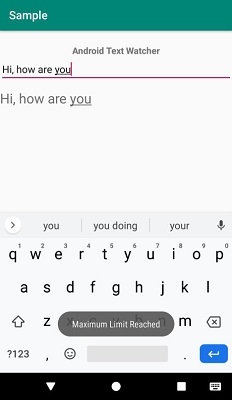This example demonstrates how do I use the Text watcher class in android.
Step 1 − Create a new project in Android Studio, go to File ⇒ New Project and fill all required details to create a new project.
Step 2 − Add the following code to res/layout/activity_main.xml.
<?xml version="1.0" encoding="utf-8"?> <RelativeLayout xmlns:android="http://schemas.android.com/apk/res/android" xmlns:tools="http://schemas.android.com/tools" android:layout_width="match_parent" android:layout_height="match_parent" tools:context=".MainActivity"> <TextView android:id="@+id/text" android:layout_width="wrap_content" android:layout_height="wrap_content" android:text="Android Text Watcher" android:textSize="16sp" android:textStyle="bold" android:layout_marginTop="24sp" android:layout_centerHorizontal="true" android:layout_alignParentTop="true" /> <EditText android:id="@+id/etInput" android:layout_width="match_parent" android:layout_height="wrap_content" android:layout_centerHorizontal="true" android:layout_below="@id/text" android:maxLength="15" android:hint="Input" /> <TextView android:id="@+id/textView" android:layout_width="fill_parent" android:layout_height="wrap_content" android:textSize="24sp" android:layout_centerHorizontal="true" android:layout_marginTop="12dp" android:layout_below="@id/etInput"/> </RelativeLayout>
Step 3 − Add the following code to src/MainActivity.java
import android.support.v7.app.AppCompatActivity; import android.os.Bundle; import android.text.Editable; import android.text.TextWatcher; import android.widget.EditText; import android.widget.TextView; import android.widget.Toast; public class MainActivity extends AppCompatActivity { EditText input; TextView output; @Override protected void onCreate(Bundle savedInstanceState) { super.onCreate(savedInstanceState); setContentView(R.layout.activity_main); input = findViewById(R.id.etInput); output = findViewById(R.id.textView); input.addTextChangedListener(textWatcher); } TextWatcher textWatcher = new TextWatcher() { @Override public void beforeTextChanged(CharSequence s, int start, int count, int after) { } @Override public void onTextChanged(CharSequence s, int start, int before, int count) { output.setText(s); if (start == 12){ Toast.makeText(getApplicationContext(), "Maximum Limit Reached", Toast.LENGTH_SHORT).show(); } } @Override public void afterTextChanged(Editable s) { } }; }
Step 4 - Add the following code to androidManifest.xml
<?xml version="1.0" encoding="utf-8"?> <manifest xmlns:android="http://schemas.android.com/apk/res/android" package="app.com.sample"> <application android:allowBackup="true" android:icon="@mipmap/ic_launcher" android:label="@string/app_name" android:roundIcon="@mipmap/ic_launcher_round" android:supportsRtl="true" android:theme="@style/AppTheme"> <activity android:name=".MainActivity"> <intent-filter> <action android:name="android.intent.action.MAIN" /> <category android:name="android.intent.category.LAUNCHER" /> </intent-filter> </activity> </application> </manifest>
OutPut
Let's try to run your application. I assume you have connected your actual Android Mobile device with your computer. To run the app from android studio, open one of your project's activity files and click Run
Icon from the toolbar. Select your mobile device as an option and then check your mobile device which will display your default screen –



